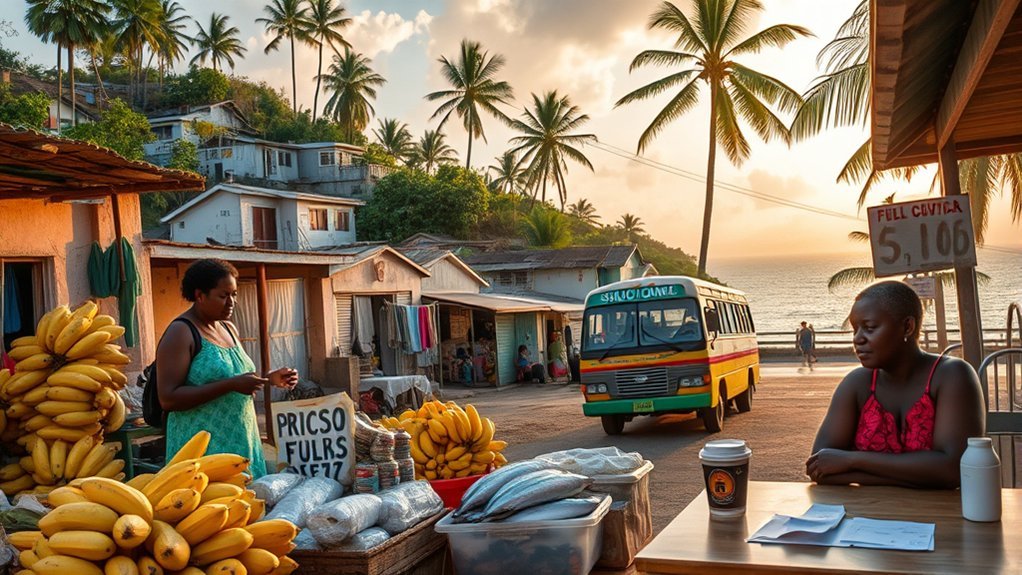You’ll need roughly $1,419 a month to live modestly in the Solomon Islands, with city-center one-bedroom rent around $600 and utilities about $163. Groceries run higher than U.S. averages due to imports (milk ~$9.73/gal), while local food and restaurants are cheaper (basic meal ~$6.08). Transit is affordable with a $24.32 monthly pass. Average local salary won’t cover these costs, so plan supplemental income and practical savings — more specifics follow below.
Overview of Living Costs in the Solomon Islands
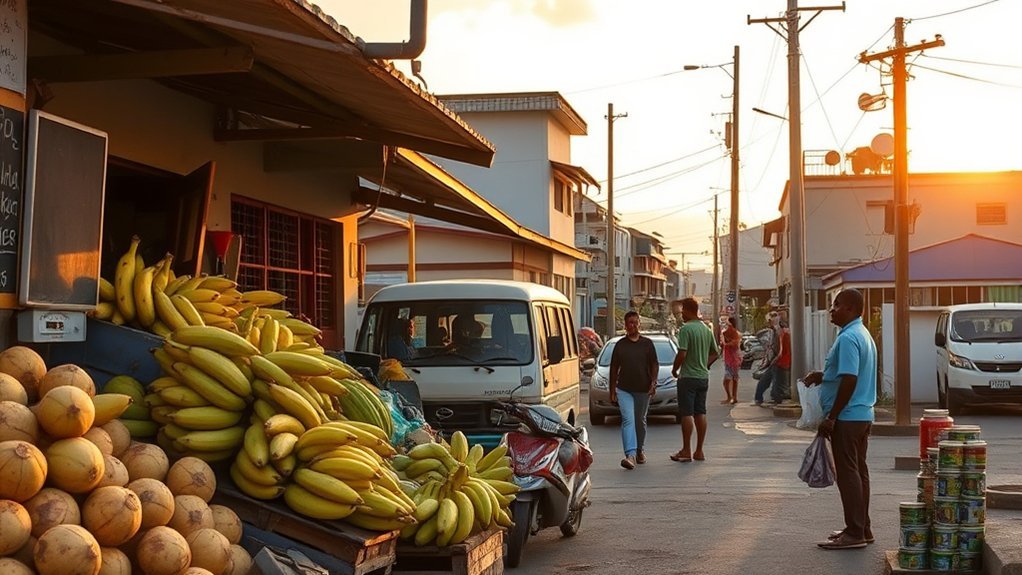
Although day-to-day expenses can vary by island, you should expect the Solomon Islands to be slightly more expensive than average—about $1,419 monthly, or 1.24× the world norm.
Expect slightly higher everyday costs in the Solomon Islands — around $1,419 monthly, about 1.24× the global average.
You’ll use the Cost of Living Index and specific data points to plan: restaurants run about 38.2% cheaper than U.S. prices, with a basic meal at roughly $6.08 versus $19.45 in the U.S.
Grocery shopping is pricier, averaging 11.1% above U.S. costs; a loaf of bread is about $1.49 compared to $3.56 in the U.S., reflecting import and supply-chain effects.
Transport is a relative bargain — a monthly public transit pass costs about $24.32, versus $65.85 in the U.S., making local travel roughly 19.2% cheaper overall.
You’ll note housing skews mixed: city-center one-bedroom rents near $600, about 5.6% higher than similar U.S. units.
These concrete figures help you budget realistically for living in the Solomon Islands.
Housing and Utilities: Prices and Tips
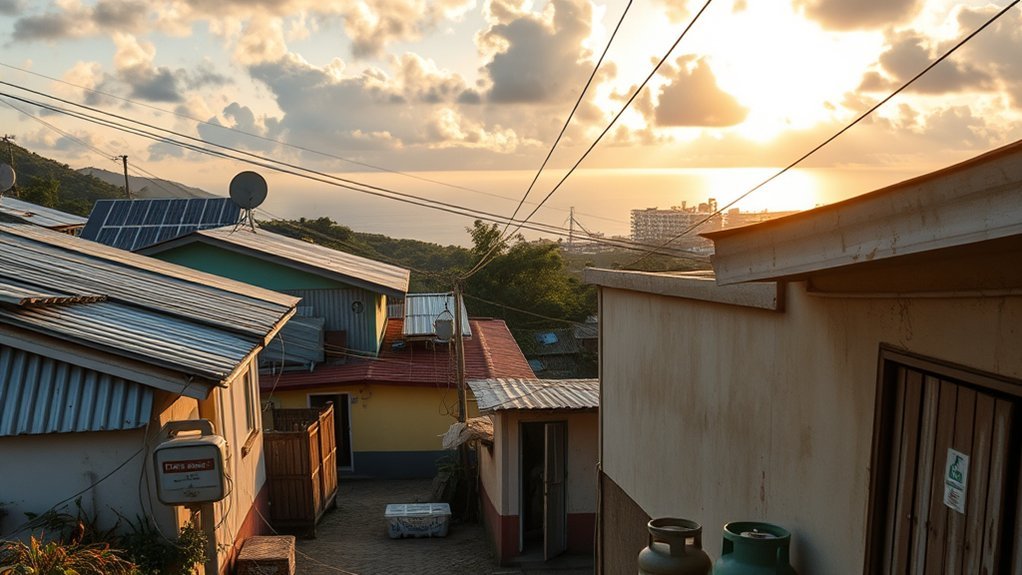
When budgeting for housing and utilities in the Solomon Islands, expect city-center one-bedroom apartments to run about $600 (with cheaper options near $571) and three-bedroom units for families around $1,345. Monthly utilities for one person average roughly $163 and reliable internet (50 Mbps+) is about $95.30.
You’ll find housing costs higher than in some regions, so factor rent and utilities as a primary budget line. Prioritize proximity to work and basic services to cut transport costs.
For utilities, monitor electricity usage and choose energy-efficient appliances to lower the ~$163 average. Negotiate lease terms and get a written agreement covering repairs and bills; clarify what’s included to avoid surprises.
If you need faster connectivity, compare providers but expect rising fees. Save by sharing larger units or choosing outskirts if commute is manageable.
Review any contract’s Terms of Use carefully before signing, and if this guide helped, Help us improve by sharing feedback.
Food and Grocery Expenses: Local vs. Imported Goods

You’ll notice local staples like bread and locally made cheese are often cheaper — a loaf is $1.49 and 8 oz of local cheese $1.99, well below US prices.
Imported items push overall grocery costs up (groceries run about 11.1% higher than the US) because of shipping, tariffs, and limited supply, which makes items like milk ($9.73/gal) and eggs ($5.49/doz) pricier.
When you shop, prioritize local produce and dairy to lower bills and reserve imports for items you can’t source locally.
Local Staples Vs Imports
Anyone shopping in the Solomon Islands will notice local staples often cost much less than imports: local cheese runs about $1.99 per 8 oz versus $6.50 for imported cheese, local chicken breast is roughly $9.49/kg, and locally grown fruits and vegetables benefit from lower transport costs.
You’ll save by buying bread, local cheese, milk produced locally, and market produce. Imported milk and specialty items push your bill up—imported milk sits near $9.73 per gallon.
Overall groceries are about 11.1% higher than in the U.S., reflecting imported-item premiums. To control costs, prioritize local proteins and produce, shop markets, and limit imported packaged goods.
That practical mix keeps your grocery budget predictable while you adapt to available local options.
Price Drivers for Groceries
Because the Solomon Islands relies heavily on imports for many packaged and dairy products, grocery prices skew higher overall—about 11.1% above U.S. levels—yet locally produced staples can be markedly cheaper: bread is $1.49 vs. $3.56 in the U.S., and 8 oz of local cheese runs $1.99 versus $6.50.
Conversely, imported-dependent items like a gallon of milk cost $9.73 (U.S. $3.97) and a dozen eggs $5.49 (U.S. $4.27), so you’ll cut your food bill by prioritizing market produce, locally raised proteins, and domestic dairy while minimizing imported and specialty purchases.
Shop local markets for fruits, vegetables and fish, buy bakery and local cheese, and treat imported milk, packaged goods, and brands as budget exceptions to control costs.
Dining Out and Entertainment Costs
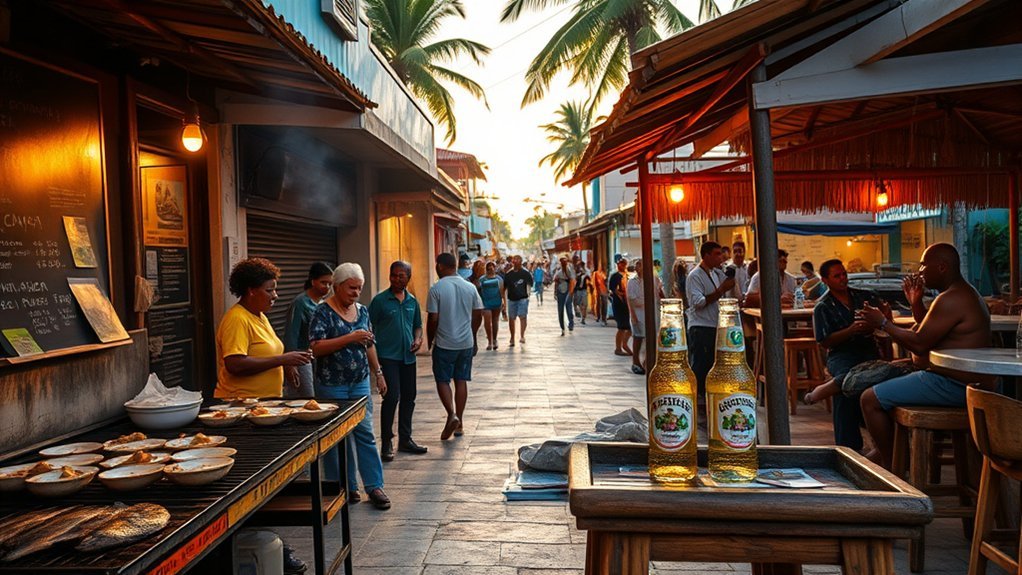
While dining out can fit a tight budget in the Solomon Islands, you’ll notice clear differences from US prices: a basic meal with a drink runs about $6.08 versus $19.45 in the US, dinner for two averages $45.10, and a fast-food combo is roughly $12.16 (slightly above the US $11.12); local beer is very cheap at $1.82 a pint, and monthly gym membership averages just $3.34 compared with $51.45 in the US.
You can eat cheaply at local cafes and markets where meals cost a fraction of US restaurant prices; a regular pattern of inexpensive lunches keeps food costs low. Dining at sit-down restaurants or ordering multiple courses raises the per-meal average, so budget accordingly for social meals. Fast food is marginally pricier than in the US, making it less of a cost-saving option.
Entertainment and fitness are affordable: inexpensive bars, low-cost drinks, and extremely cheap gym memberships reduce monthly leisure spending considerably. Plan based on how often you dine out and the type of venues you prefer.
Transportation and Commuting Expenses
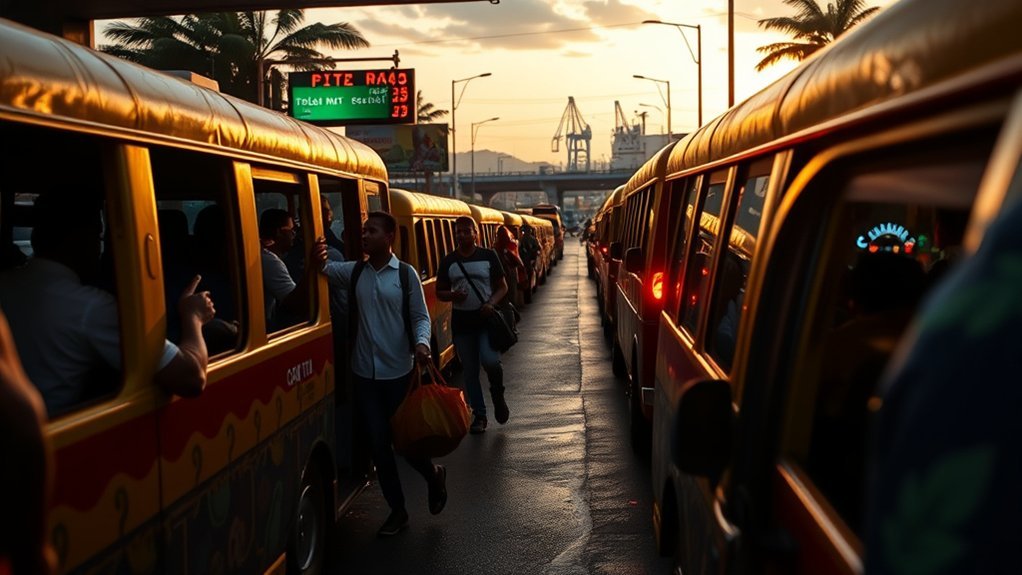
Transportation in the Solomon Islands stays affordable for short trips but can get pricey if you drive. If you rely on public options, a local transport ticket costs about $0.36, and a monthly transit pass runs $24.32 — considerably cheaper than US averages. Those numbers make daily commuting by shared transport or minibus very economical.
Taxis are accessible and reasonably priced for short distances: a downtown 5-mile ride is roughly $10.94, and an 8 km trip about $11. If you need regular taxi use, costs add up but remain lower than many US cities.
Fuel is the major driver of private vehicle expense: gasoline is around $4.90 per gallon, noticeably higher than the US rate of $3.41, so expect elevated running costs and maintenance for cars.
Plan around public transit and occasional taxis to keep commuting affordable; owning and driving a car will markedly increase your monthly transport budget.
Childcare, Education, and Healthcare Costs
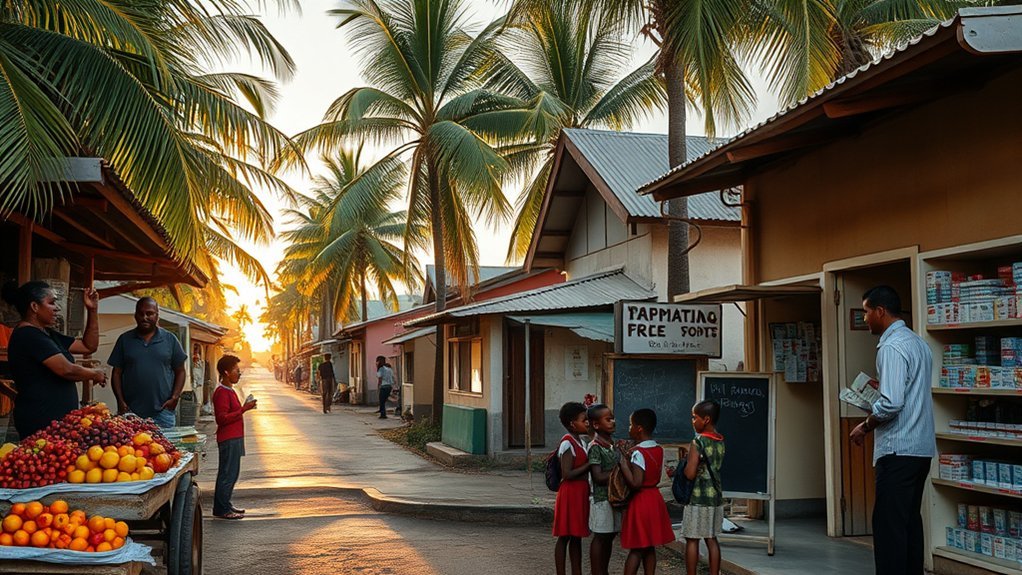
When budgeting for family life in the Solomon Islands, you’ll find private preschool runs about $97.28 per month per child—roughly 90.5% cheaper than U.S. childcare.
Middle school tuition for one child across two semesters is about $2,796.75, compared with a U.S. average near $23,196.46, so schooling is also markedly more affordable.
Don’t forget to factor in healthcare service expenses and the 31.7% English-speaking rate, which can affect access and costs for expatriate families.
Childcare Monthly Fees
One clear advantage you’ll notice in the Solomon Islands is the low monthly cost of private preschool—about $97.28 per child—making childcare roughly 90.5% cheaper than the U.S. average and freeing up household funds for other essentials.
You’ll pay a fraction of U.S. preschool rates, so monthly budgeting for working parents becomes straightforward: allocate roughly $100 per child rather than over $1,300. That gap lets you redirect savings toward housing, food, or healthcare.
Middle school two-semester costs are noted at $2,796.75 locally versus $23,196.46 in the U.S., reinforcing long-term education affordability.
In practice, you can expect consistent, measurable savings from early childhood through lower secondary expenses, improving overall household financial resilience.
School Tuition Costs
Although education and care vary by provider, you’ll typically pay far less for schooling in the Solomon Islands than in the U.S.: private preschool runs about $97.28 per month versus $1,387.27 in the U.S., and middle-school tuition for two semesters averages $2,796.75 locally compared with $23,196.46 stateside.
You’ll see roughly 90.5% lower childcare and tuition costs overall, so budgeting for children is markedly easier. Expect lower fees at most local private and community schools, though international or mission schools may charge more.
Factor in modest ancillary expenses—uniforms, supplies, transport—and occasional activity fees. With restaurant meals around $6.08, daily child-related costs stay manageable.
Compare schools directly, verify curriculum and extracurricular offerings, and prioritize value over sticker price.
Healthcare Service Expenses
Because healthcare services in the Solomon Islands are generally cheaper than in Western countries, you’ll usually pay less for routine visits, basic treatments, and pediatric care, though prices vary by facility and island.
You’ll find childcare and education costs follow the same pattern: private preschool runs about $97.28 per month—roughly 90.5% cheaper than U.S. rates—and middle school for two semesters is about $2,796.75 versus $23,196.46 in the U.S.
That context matters when budgeting for family health needs, vaccinations, or outpatient care. Expect lower unit costs but variable availability of specialists, diagnostics, and emergency care.
Plan for medication imports or private referrals to neighboring countries when advanced services are needed, and build a contingency fund for unexpected medical transfers.
Average Salaries, Purchasing Power, and Budgeting
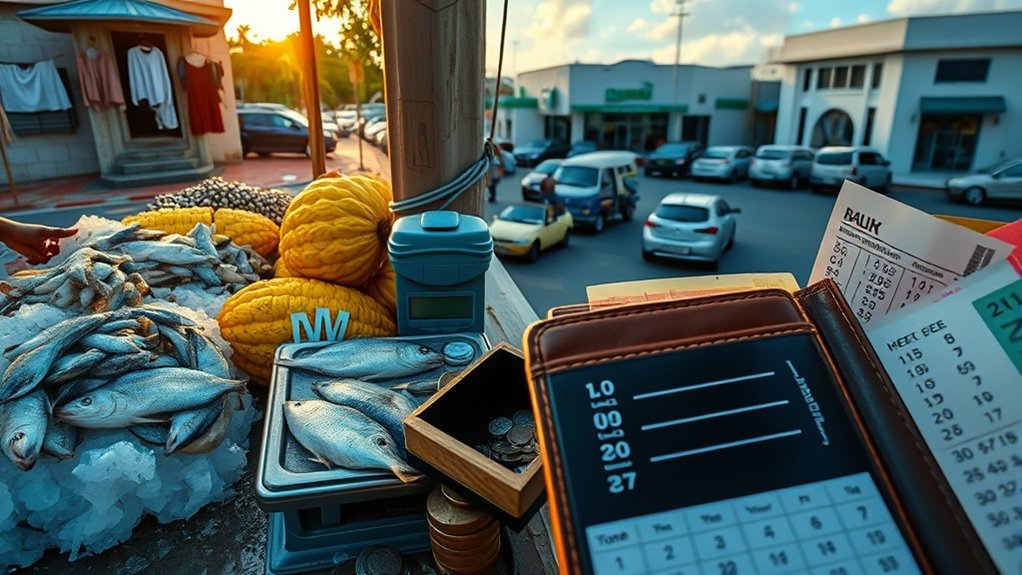
Averaging about $172 after taxes per month, salaries in the Solomon Islands fall far short of typical expenses, where the estimated monthly cost of living sits at roughly $1,419. You’ll face a purchasing-power shortfall: the average wage covers only about 0.1 months of living costs.
The country ranks 41st of 197 for costliness, at 1.24× the world average, so prices aren’t negligible relative to income levels.
Budgeting starts with fixed essentials: expect housing to take a large share — roughly $600 for a one-bedroom city-center apartment (or about $571 for cheaper options).
Add utilities at approximately $163 and internet at $95.30; these three alone can exceed the average salary multiple times.
When you project monthly obligations, discretionary spending is minimal without supplemental income.
Plan budgets that prioritize rent, utilities, and connectivity, and quantify any income gaps clearly so you can evaluate feasibility before committing to relocation or long-term residence.
Practical Tips for Saving Money and Preparing to Move
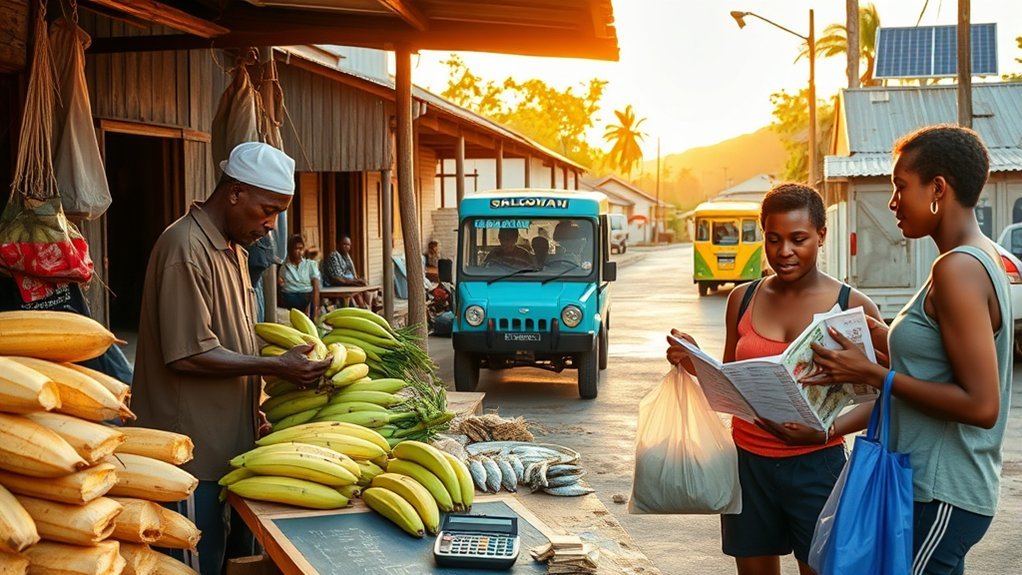
If you’re planning a move to the Solomon Islands, start by mapping fixed monthly costs against your expected income so you can see any shortfall immediately; rent for a one‑bed city apartment (~$600), utilities (~$163), and internet (~$95) already exceed typical local salaries by several times.
Prioritize housing research—look for shared rentals or outskirts locations to cut rent. Reduce food costs by eating at local restaurants (basic meal ~$6.08) and buying local produce; restaurant meals are about 38.2% cheaper than in the US.
Build a grocery list that tracks item extremes: local cheese can be inexpensive (~$1.99) while milk may be costly (~$9.73/gal). Use public transit—monthly passes cost ~$24.32, roughly 19.2% cheaper than US equivalents—and limit taxi use.
If you have kids, factor in low private preschool fees (~$97.28/month). Create a three‑month emergency fund, arrange reliable international banking, and ship nonessentials after you settle to avoid high upfront shipping and replacement costs.
Frequently Asked Questions
Are Solomon Islands Expensive?
Yes — you’ll find the Solomon Islands relatively expensive overall: average living costs are about $1,419 (1.24× world average). Restaurants and transport are cheaper, but groceries and general living expenses drive higher costs.
How Long Can a US Citizen Stay in the Solomon Islands?
You can stay up to 90 days visa-free as a US citizen, and you’ll need a passport valid six months plus an onward ticket; you can apply to extend at Immigration, though approval isn’t guaranteed—check current rules first.
What Is the Average Monthly Income in the Solomon Islands?
The average monthly income in the Solomon Islands is about $172 after taxes. You’ll note that’s extremely low, covering roughly 0.1 months of typical living costs, reflecting limited purchasing power and significant expense gaps.
Is Leonardo DiCaprio in the Solomon Islands?
No, he isn’t in the Solomon Islands; you shouldn’t expect sightings. Think of him as a distant lighthouse guiding conservation efforts — you’ll find his advocacy aligns with protecting such ecosystems, but not a physical presence there.
Conclusion
Living in the Solomon Islands can be affordable if you plan wisely: housing and local food are cheap, while imported goods, fuel, and private schooling push costs up. Expect mid-range monthly expenses around SBD 6,000–12,000 (USD 750–1,500) depending on lifestyle. Budget for utilities, internet, and occasional medevacs. Shop local, use public transport, and negotiate rents to stretch your income—think of your budget as a sail: trim it to catch the best wind.

